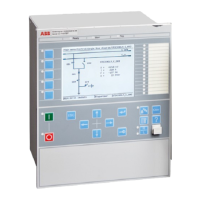The fault current, in the fault point, can be calculated as:
phase
j 0
0 f
3 U
I 3I
Z 3 R
×
= =
+ ×
EQUATION1944 V1 EN-US (Equation 47)
The impedance Z
0
is dependent on the system earthing. In an isolated system (without neutral
point apparatus) the impedance is equal to the capacitive coupling between the phase
conductors and earth:
phase
0 c
j
3 U
Z jX j
I
×
= - = -
EQUATION1945 V1 EN-US (Equation 48)
Where
I
j
is the capacitive earth fault current at a non-resistive phase-to-earth fault
X
c
is the capacitive reactance to earth
In a system with a neutral point resistor (resistance earthed system) the impedance Z
0
can be
calculated as:
c n
0
c n
jX 3R
Z
jX 3R
- ×
=
- +
EQUATION1946 V1 EN-US (Equation 49)
Where
R
n
is the resistance of the neutral point resistor
In many systems there is also a neutral point reactor (Petersen coil) connected to one or more
transformer neutral points. In such a system the impedance Z
0
can be calculated as:
( )
n n c
0 c n n
n c n n c
9R X X
Z jX // 3R // j3X
3X X j3R 3X X
= - =
+ × -
EQUATION1947 V1 EN-US
(Equation 50)
Where
X
n
is the reactance of the Petersen coil. If the Petersen coil is well tuned we have 3X
n
= X
c
In this case the
impedance Z
0
will be: Z
0
= 3R
n
Now consider a system with an earthing via a resistor giving higher earth fault current than the
high impedance earthing. The series impedances in the system can no longer be neglected.
The system with a single phase to earth fault can be described as in Figure
64.
Section 7 1MRK 511 358-UEN A
Current protection
136
Application manual

